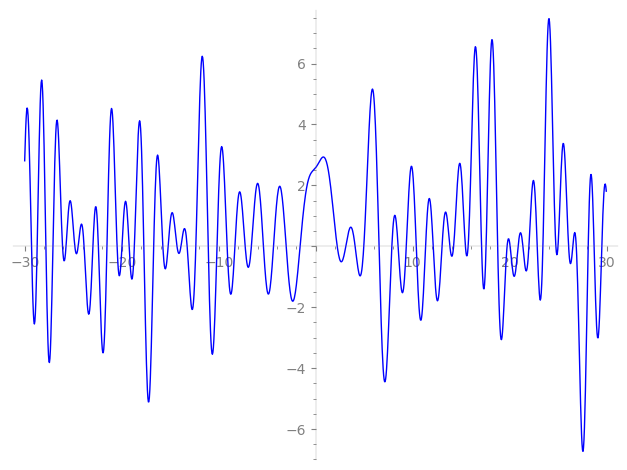| L(s) = 1 | + (0.813 + 0.813i)2-s + (1.89 − 0.786i)3-s − 0.677i·4-s + (2.18 + 0.904i)6-s + (0.143 − 0.346i)7-s + (2.17 − 2.17i)8-s + (0.866 − 0.866i)9-s + (0.0511 + 0.0211i)11-s + (−0.532 − 1.28i)12-s + 0.388i·13-s + (0.398 − 0.165i)14-s + 2.18·16-s + (−4.08 − 0.594i)17-s + 1.40·18-s + (1.25 + 1.25i)19-s + ⋯ |
| L(s) = 1 | + (0.575 + 0.575i)2-s + (1.09 − 0.454i)3-s − 0.338i·4-s + (0.891 + 0.369i)6-s + (0.0543 − 0.131i)7-s + (0.769 − 0.769i)8-s + (0.288 − 0.288i)9-s + (0.0154 + 0.00639i)11-s + (−0.153 − 0.371i)12-s + 0.107i·13-s + (0.106 − 0.0441i)14-s + 0.546·16-s + (−0.989 − 0.144i)17-s + 0.332·18-s + (0.287 + 0.287i)19-s + ⋯ |
Λ(s)=(=(425s/2ΓC(s)L(s)(0.981+0.189i)Λ(2−s)
Λ(s)=(=(425s/2ΓC(s+1/2)L(s)(0.981+0.189i)Λ(1−s)
| Degree: |
2 |
| Conductor: |
425
= 52⋅17
|
| Sign: |
0.981+0.189i
|
| Analytic conductor: |
3.39364 |
| Root analytic conductor: |
1.84218 |
| Motivic weight: |
1 |
| Rational: |
no |
| Arithmetic: |
yes |
| Character: |
χ425(376,⋅)
|
| Primitive: |
yes
|
| Self-dual: |
no
|
| Analytic rank: |
0
|
| Selberg data: |
(2, 425, ( :1/2), 0.981+0.189i)
|
Particular Values
| L(1) |
≈ |
2.57171−0.246532i |
| L(21) |
≈ |
2.57171−0.246532i |
| L(23) |
|
not available |
| L(1) |
|
not available |
L(s)=p∏Fp(p−s)−1 | p | Fp(T) |
|---|
| bad | 5 | 1 |
| 17 | 1+(4.08+0.594i)T |
| good | 2 | 1+(−0.813−0.813i)T+2iT2 |
| 3 | 1+(−1.89+0.786i)T+(2.12−2.12i)T2 |
| 7 | 1+(−0.143+0.346i)T+(−4.94−4.94i)T2 |
| 11 | 1+(−0.0511−0.0211i)T+(7.77+7.77i)T2 |
| 13 | 1−0.388iT−13T2 |
| 19 | 1+(−1.25−1.25i)T+19iT2 |
| 23 | 1+(−0.948−0.392i)T+(16.2+16.2i)T2 |
| 29 | 1+(−3.23−7.80i)T+(−20.5+20.5i)T2 |
| 31 | 1+(−5.59+2.31i)T+(21.9−21.9i)T2 |
| 37 | 1+(8.77−3.63i)T+(26.1−26.1i)T2 |
| 41 | 1+(−2.93+7.08i)T+(−28.9−28.9i)T2 |
| 43 | 1+(4.77−4.77i)T−43iT2 |
| 47 | 1+1.84iT−47T2 |
| 53 | 1+(6.43+6.43i)T+53iT2 |
| 59 | 1+(9.61−9.61i)T−59iT2 |
| 61 | 1+(2.22−5.36i)T+(−43.1−43.1i)T2 |
| 67 | 1−14.4T+67T2 |
| 71 | 1+(1.04−0.430i)T+(50.2−50.2i)T2 |
| 73 | 1+(−0.838−2.02i)T+(−51.6+51.6i)T2 |
| 79 | 1+(3.64+1.50i)T+(55.8+55.8i)T2 |
| 83 | 1+(6.67+6.67i)T+83iT2 |
| 89 | 1−2.61iT−89T2 |
| 97 | 1+(2.01+4.85i)T+(−68.5+68.5i)T2 |
| show more | |
| show less | |
L(s)=p∏ j=1∏2(1−αj,pp−s)−1
Imaginary part of the first few zeros on the critical line
−11.08677137341586041733196629094, −10.17738173047988900781600477230, −9.132993080197832337846846142379, −8.330028800296717865412940522454, −7.27288774008674148911779260335, −6.63169072313655730863751743001, −5.38991975171489226893034950266, −4.35067557353121339739822789792, −3.04729406460627786292373446954, −1.60991926625598015347227448754,
2.21549020727799240269326217034, 3.09891805997689678098532492543, 4.06118160169683352131669175759, 4.95609822308764486165912723614, 6.52620224770816765602865735906, 7.84712163122586239106768569043, 8.493178924467650782278855873502, 9.334855909157935462848305150201, 10.36303571760696286380053339133, 11.32473298739174924628294415275

